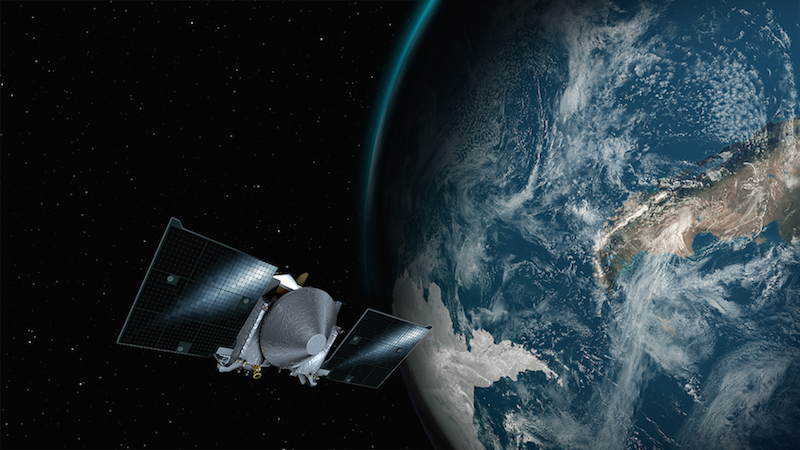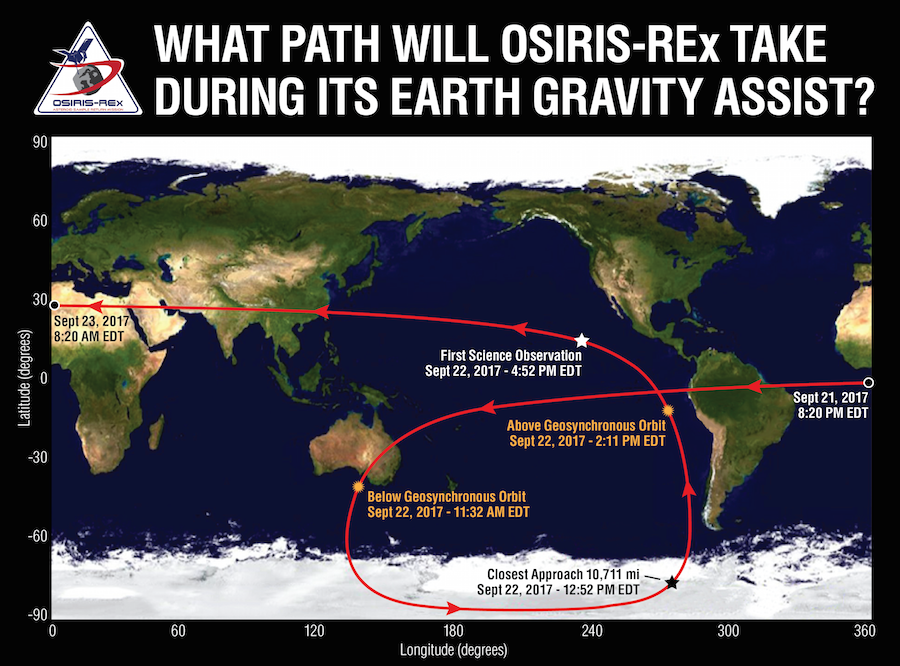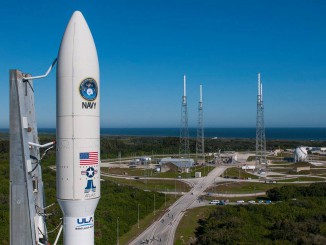EDITOR’S NOTE: Updated at 4:30 p.m. EDT (2030 GMT) after flyby.

NASA’s OSIRIS-REx spacecraft, en route to asteroid Bennu to retrieve samples and return them to scientists, slingshot past Earth on Friday, using gravity to change its trajectory for a rendezvous with its target late next year.
One year since it launched from Cape Canaveral aboard an Atlas 5 rocket, OSIRIS-REx returned to Earth on Friday with a high-speed encounter that too the probe about 10,771 miles (17,237 kilometers) over the planet. The solar-powered spacecraft will make its closest approach to Earth at 1652 GMT (12:52 p.m. EDT) Friday, passing over Antarctica, just south of Cape Horn, Chile.
Navigators confirmed OSIRIS-REx’s trajectory would not go near any satellites or space junk tracked in Earth orbit, officials said.
OSIRIS-REx approached Earth at a relative velocity of 19,000 mph — more than 30,000 kilometers per hour — after traveling almost 600 million miles (1 billion kilometers) since its blastoff Sept. 8, 2016. The spacecraft spent the last year orbiting the sun, fine-tuning its flight path with several engine and thruster firings to aim for Friday’s Earth flyby.
The spacecraft got a gravitational kick from the encounter, employing Earth’s gravity to redirect its orbit toward asteroid Bennu, an object measuring around 1,600 feet (500 meters) in diameter. Bennu circles the sun on a course tilted roughly 6 degrees from the plane of Earth’s orbit, requiring OSIRIS-REx to fight against the sun’s gravitational pull to reach the asteroid.
Friday’s flyby imparted a change in OSIRIS-REx’s velocity of around 8,451 mph — nearly 3.8 kilometers per second — around twice the adjustment possible if the spacecraft dedicated all of its fuel to the maneuver.
Manufactured by Lockheed Martin, OSIRIS-REx would have needed a much bigger, and more expensive, launcher to fly directly from Earth to Bennu, or carry a heavier load of fuel, a design change that would also have necessitated a larger rocket.
“It was a way to substantially save on resources, either on the spacecraft or on the launch vehicle, or both,” said Dante Lauretta, OSIRIS-REx’s principal investigator from the University of Arizona.
The gravity assist was similar to maneuvers used on many interplanetary missions, and the slingshot effect is natural, requiring no input from the spacecraft once it’s on course for the flyby.
“The encounter with Earth is fundamental to our rendezvous with Bennu,” said Rich Burns, OSIRIS-REx project manager at NASA’s Goddard Space Flight Center in Greenbelt, Maryland. “The total velocity change from Earth’s gravity far exceeds the total fuel load of the OSIRIS-REx propulsion system, so we are really leveraging our Earth flyby to make a massive change to the OSIRIS-REx trajectory, specifically changing the tilt of the orbit to match Bennu.”
NASA expected to regain communications with OSIRIS-REx around 1740 GMT (1:40 p.m. EDT), and the spacecraft was to begin collecting imagery and calibration data with its science instruments around four hours after closest approach at a distance of approximately 60,000 miles (100,000 kilometers) from Earth.
The space agency announced Friday afternoon that spacecraft executed the gravity assist maneuver as planned.

According to Lauretta, OSIRIS-REx’s three imaging cameras will look back at Earth and the moon for up to 10 days after the encounter, capturing close-up and long-range views, including a family portrait of the Earth-moon system.
The spacecraft closed in on Earth above the night side of the planet, meaning the best views will come on OSIRIS-REx’s outbound leg as it departs over the Pacific Ocean.
OSIRIS-REx’s thermal emission spectrometer and visible and infrared spectrometer will also collect data on Earth for calibration, ensuring the accuracy of measurements gathered at Bennu. The mission’s Canadian-built laser altimeter and a student-built dust experiment will not be fully activated until arrival at Bennu.
Images from the flyby will be released Tuesday, officials said.
“The spacecraft is doing extremely well,” Lauretta said in an interview with Spaceflight Now before the flyby. “We have checked out all of the spacecraft subsystems, and everything is woking as expected. The instruments have gone through two checkout and calibration campaigns.”
OSIRIS-REx is short for the Origins, Spectral Interpretation, Resource Identification, and Security – Regolith Explorer, an approximately $1 billion mission funded by NASA to travel to asteroid Bennu, snag at least 2.1 ounces — 60 grams — of surface material, and return the specimens to Earth in September 2023.
Next up for the mission will be a series of course correction burns over the next year to set up for the final approach to Bennu.
Science observations of Bennu will begin in August 2018, and detailed images of Bennu should be acquired by OSIRIS-REx in October. Analysts will look for evidence of debris or moons in the asteroid’s vicinity before OSIRIS-REx’s arrival.
“The encounter, as the flight dynamicists think about it, happens in November of 2018,” Lauretta said. “That’s when we’ll actually do a close approach over the north pole of the asteroid with an imaging campaign, and then do a couple of maneuvers and repeat that sequence multiple times.”
OSIRIS-REx will go into orbit around the asteroid and identify locations where the probe’s sampling mechanism could scoop up material for return to Earth. The mission is the first asteroid sample return attempt mounted by NASA, and the second worldwide after Japan’s Hayabusa mission brought back microscopic specimens from asteroid Itokawa in 2010.
Some time in July 2020, a robotic arm will reach down to the asteroid’s surface with a device that will unleash a pulse of compressed nitrogen gas, scouring up bits of dust and rock into a collection chamber.
The spacecraft will leave Bennu in 2021 for the cruise back to Earth, where it will drop the sample-carrying canister for re-entry and a parachute-assisted landing in Utah on Sept. 24, 2023. Scientists will inspect and analyze the samples in a special clean room at NASA’s Johnson Space Center in Houston, looking for signs of organic molecules and other primordial building blocks that formed the planets and seeded life.
“This is really giving us a taste of what we’re going to experience next year, and I think it’s the start of building the excitement for our asteroid encounter,” Lauretta said of Friday’s flyby of Earth.
Email the author.
Follow Stephen Clark on Twitter: @StephenClark1.



